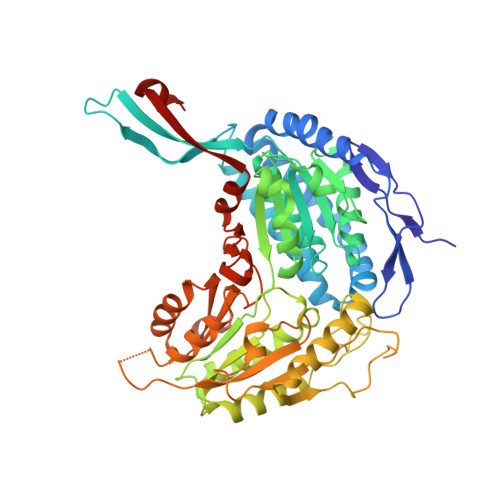Structural and Biochemical Characterization of a Novel Aldehyde Dehydrogenase Encoded by the Benzoate Oxidation (Box) Pathway in Burkholderia Xenovorans Lb400
Bains, J., Boulanger, M.J.(2008) J Mol Biology 379: 597
- PubMed: 18462753
- DOI: https://doi.org/10.1016/j.jmb.2008.04.031
- Primary Citation of Related Structures:
2VRO - PubMed Abstract:
The recently identified benzoate oxidation (box) pathway in Burkholderia xenovorans LB400 (LB400 hereinafter) assimilates benzoate through a unique mechanism where each intermediate is processed as a coenzyme A (CoA) thioester. A key step in this process is the conversion of 3,4-dehydroadipyl-CoA semialdehyde into its corresponding CoA acid by a novel aldehyde dehydrogenase (ALDH) (EC 1.2.1.x). The goal of this study is to characterize the biochemical and structural properties of the chromosomally encoded form of this new class of ALDHs from LB400 (ALDH(C)) in order to better understand its role in benzoate degradation. To this end, we carried out kinetic studies with six structurally diverse aldehydes and nicotinamide adenine dinucleotide (phosphate) (NAD(+) and NADP(+)). Our data definitively show that ALDH(C) is more active in the presence of NADP(+) and selective for linear medium-chain to long-chain aldehydes. To elucidate the structural basis for these biochemical observations, we solved the 1.6-A crystal structure of ALDH(C) in complex with NADPH bound in the cofactor-binding pocket and an ordered fragment of a polyethylene glycol molecule bound in the substrate tunnel. These data show that cofactor selectivity is governed by a complex network of hydrogen bonds between the oxygen atoms of the 2'-phosphoryl moiety of NADP(+) and a threonine/lysine pair on ALDH(C). The catalytic preference of ALDH(C) for linear longer-chain substrates is mediated by a deep narrow configuration of the substrate tunnel. Comparative analysis reveals that reorientation of an extended loop (Asn478-Pro490) in ALDH(C) induces the constricted structure of the substrate tunnel, with the side chain of Asn478 imposing steric restrictions on branched-chain and aromatic aldehydes. Furthermore, a key glycine (Gly104) positioned at the mouth of the tunnel allows for maximum tunnel depth required to bind medium-chain to long-chain aldehydes. This study provides the first integrated biochemical and structural characterization of a box-pathway-encoded ALDH from any organism and offers insight into the catalytic role of ALDH(C) in benzoate degradation.
- Department of Biochemistry and Microbiology, University of Victoria, PO Box 3055 STN CSC, Victoria, BC, Canada.
Organizational Affiliation:



















